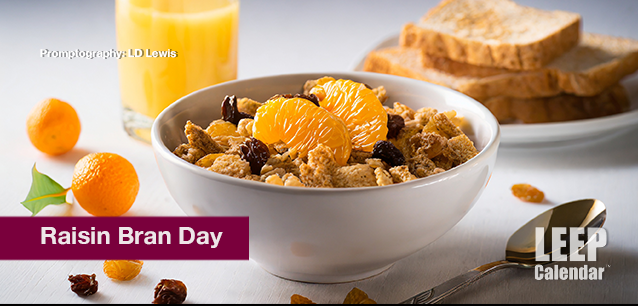 AD
AD
Today is: April 08
Scroll to explore events active on this date.
LEEP INK FEATURES

Metamorphic March: Trends and events in March 2025
Welcome to Spring or Autumn. This is a transitional month with something for everyone. Internationally, it is Women's History Month, focusing on the achievements, needs, and challenges that women ...

February Favorites
The world steps into the second month of 2025 with hope and trepidation. The United States has a new administration. Canada is finding its way to a new administration. Germany and several other European nations...

Part II
There are several unique focuses for 2025. I covered the first 12 in Part One. The following are the rest I have discovered for this year. As with all issues of LEEP Ink, the following descriptions are a...
About Raisin Bran Day
United States
Ends: Nov 15, 2025
DESCRIPTION:
Raisin Bran Day is an unsponsored, unofficial event that appeared online some years ago.
Raisin Bran, a popular breakfast cereal known for its combination of crunchy bran flakes and sweet raisins, has a history that reflects broader trends in American food culture. Originating in the United States during the early 20th century, Raisin Bran was part of a larger movement towards more convenient and health-conscious food options.
The concept of Raisin Bran emerged as part of the broader development of ready-to-eat cereals, which began in the late 19th and early 20th centuries. This period saw a shift in American breakfast habits, moving away from heavier, cooked breakfasts towards lighter, more convenient options. Cereal companies, recognizing a growing interest in health and nutrition, began to explore bran—a byproduct of milling wheat—as a key ingredient for its high fiber content.
Raisin Bran made its debut in the early 1920s. It was one of the first cereals to incorporate fruit, a move that added natural sweetness and appealed to the health-conscious consumer. The combination of bran flakes, known for aiding digestion, and raisins, appreciated for their vitamins and minerals, was marketed as a wholesome, nutritious start to the day.
Several cereal companies, including the United States company Mills and Skinner's, claim to be the first to introduce Raisin Bran. However, the Kellogg Company's version, introduced in 1942, became most widely recognized. Kellogg's capitalized on the popularity of the cereal by improving the raisin-to-bran ratio and enhancing the flavor profile, solidifying Raisin Bran's place in the American breakfast landscape.
Over the decades, Raisin Bran has adapted to changing consumer preferences, with variations including different types of raisins, the addition of other fruits, and even bran flakes with different textures and nutritional profiles. Despite these variations, the core appeal of Raisin Bran has remained its combination of health benefits and convenience, a reflection of ongoing trends in consumer eating habits.
VIDEOS
SUPPORTING DOCUMENTS
Currently, this event does not have supporting documents.
ADDITIONAL IMAGES
Currently, this event does not have supporting images.
Where would you like to go now?
 AD
AD


/footer-logo.svg)
